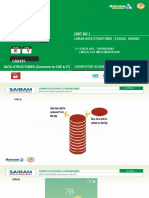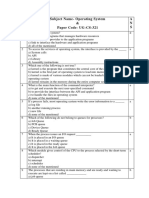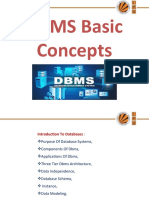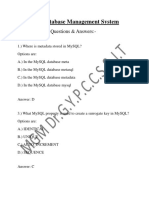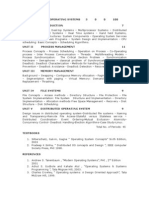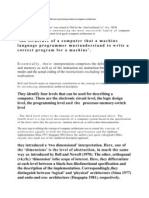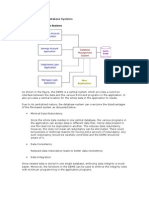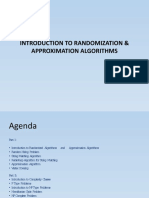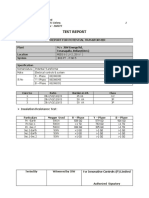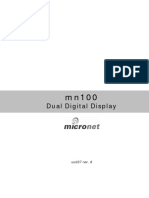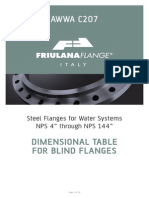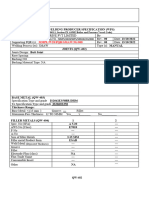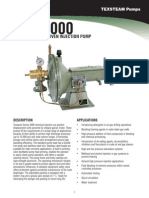Operating Systems UNIT 5
I/O and File Management
�Outline
File Concept and Structure Directory Structures File Organizations Access Methods Protection
�File Concept
Contiguous logical address space
OS abstracts from the physical properties of its storage device to define a logical storage unit called file. OS maps files to physical devices.
Data
Types
numeric, character, binary source, object (load image)
Program
Documents
�File Structure
None - sequence of words/bytes Simple record structure
Lines Fixed Length Variable Length Formatted document Relocatable Load File
Complex Structures
Can simulate last two with first method by inserting appropriate control characters Who decides
Operating System Program
�File Attributes
Name
symbolic file-name, only information in human-readable form for systems that support multiple types pointer to a device and to file location on device
Type
Location Size
current file size, maximal possible size
controls who can read, write, execute data for protection, security and usage monitoring
Protection Time, Date and user identification
Information about files are kept in the directory structure, maintained on disk
�File Operations
A file is an abstract data type. It can be defined by operations:
Create a file Write a file Read a file Reposition within file - file seek Delete a file Truncate a file Open(Fi)
search the directory structure on disk for entry Fi, and move the content of entry to memory. move the content of entry Fi in memory to directory structure on disk.
Close(Fi)
�File types - name.extension
File Type
Executable Object Source code Batch text Print, view archive Library
Possible extension
Exe,com,bin Obj, o c, CC, p, java, asm Bat, sh Txt, doc ps, dvi, gif Arc, zip, tar Lib, a
Function
Machine language program Compiled machine lang., not linked Source code in various languages Commands to command interpreter Textual data, documents ASCII or binary file Group of files, sometimes compressed Libraries of routines
�Directory Structure
Number of files on a system can be extensive
Break file systems into partitions ( treated as a separate storage device) Hold information about files within partitions.
Device Directory: A collection of nodes containing information about all files on a partition. Both the directory structure and files reside on disk. Backups of these two structures are kept on tapes.
�Information in a Device Directory
File Name File Type Address or Location Current Length Maximum Length Date created, Date last accessed (for archival), Date last updated (for dump) Owner ID (who pays), Protection information
Also on a per file, per process basis
Current position - read/write position usage count
�Operations Performed on Directory
Search for a file Create a file Delete a file List a directory Rename a file Traverse the filesystem
�Logical Directory Organization -Goals
Efficiency - locating a file quickly Naming - convenient to users
Two users can have the same name for different files. The same file can have several different names. Logical grouping of files by properties (e.g. all Pascal programs, all games)
Grouping
�Single Level Directory
A single directory for all users Naming Problem and Grouping Problem
As the number of files increases, difficult to remember unique names As the number of users increase, users must have unique names.
�Two Level Directory
Introduced to remove naming problem between users
First Level contains list of user directories Second Level contains user files Need to specify Path name Can have same file names for different users. System files kept in separate directory or Level 1. Efficient searching
�Two Level Directory
�Tree structured Directories
�Tree Structured Directories
Arbitrary depth of directories
Leaf nodes are files, interior nodes are directories.
Efficient Searching Grouping Capability Current Directory (working directory)
cd /spell/mail/prog type list
MS-DOS uses a tree structured directory
�Tree Structured Directories
Absolute or relative path name
Absolute from root Relative paths from current working directory pointer.
Creating a new file is done in current directory Creating a new subdirectory is done in current directory, e.g. mkdir <dir-name> Delete a file , e.g. rm file-name Deletion of directory
Option 1 : Only delete if directory is empty Option 2: delete all files and subdirectories under directory
�Acyclic Graph Directories
�Acyclic Graph Directories
Acyclic graphs allow sharing Implementation by links
Links are pointers to other files or subdirectories Symbolic links or relative path name
Directory entry is marked as a link and name of real file/directory is given. Need to resolve link to locate file.
Implementation by shared files
Duplicate information in sharing directories Original and copy indistinguishable. Need to maintain consistency if one of them is modified.
�Acyclic Graph Directories
Naming : File may have multiple absolute path names
Two different names for the same file
Traversal
ensure that shared data structures are traversed only once.
Deletion
Removing file when someone deletes it may leave dangling pointers. Preserve file until all references to it are deleted
Keep a list of all references to a file or Keep a count of the number of references - reference count. When count = 0, file can be deleted.
�General Graph Directories
�General Graph Directories (cont.)
How do we guarantee no cycles in a tree structured directory?
Allow only links to file not subdirectories. Every time a new link is added use a cycle detection algorithm to determine whether it is ok.
If links to directories are allowed, we have a simple graph structure
Need to ensure that components are not traversed twice both for correctness and for performance, e.g. search can be non-terminating. Need garbage collection mechanism to determine if file can be deleted.
File Deletion - reference count can be non-zero
�Access Methods
Sequential Access
read next write next reset no read after last write (rewrite)
Direct Access ( n = relative block number)
read n write n position to n read next write next rewrite n
�Protection
File owner/creator should be able to control
what can be done by whom
read write execute append delete list
Types of access
�Access lists and groups
Associate each file/directory with access list
Problem - length of access list.. Mode of access: read, write, execute Three classes of users
Solution - condensed version of list
owner access - user who created the file groups access - set of users who are sharing the file and need similar access public access - all other users Fields are user, group, others(u,g,o), Bits are read, write, execute (r,w,x). E.g. chmod go+rw file , chmod 761 game
In UNIX, 3 fields of length 3 bits are used.
�File-System Implementation
File System Structure Allocation Methods Free-Space Management Directory Implementation Efficiency and Performance Recovery
�File-System Structure
File Structure
Logical Storage Unit with collection of related information To improve I/O efficiency, I/O transfers between memory and disk are performed in blocks.
File System resides on secondary storage (disks).
Read/Write/Modify/Access each block on disk.
File system organized into layers. File control block - storage structure consisting of information about a file.
�File System Mounting
File System must be mounted before it can be available to process on the system
The OS is given the name of the device and the mount point (location within file structure at which files attach). OS verifies that the device contains a valid file system. OS notes in its directory structure that a file system is mounted at the specified mount point.
�Allocation of Disk Space
Low level access methods depend upon the disk allocation scheme used to store file data
Contiguous Allocation Linked List Allocation Block Allocation
�Contiguous Allocation
Each file occupies a set of contiguous blocks on the disk.
Simple - only starting location (block #) and length (number of blocks) are required. Suits sequential or direct access. Fast (very little head movement) and easy to recover in the event of system crash.
Problems
Wasteful of space (dynamic storage-allocation problem). Use first fit or best fit. Leads to external fragmentation on disk. Files cannot grow - expanding file requires copying Users tend to overestimate space - internal fragmentation.
Block to be accessed = Q + starting address Displacement into block = R
Mapping from logical to physical - <Q,R>
�Contiguous Allocation
�Linked Allocation
Each file is a linked list of disk blocks
Blocks may be scattered anywhere on the disk. Each node in list can be a fixed size physical block or a contiguous collection of blocks. Allocate as needed and then link together via pointers.
Disk space used to store pointers, if disk block is 512 bytes, and pointer (disk address) requires 4 bytes, user sees 508 bytes of data.
pointer Block = Data
Pointers in list not accessible to user.
�Linked Allocation
�Linked Allocation
Simple - need only starting address. Free-space management system - space efficient.
Can grow in middle and at ends. No estimation of size necessary.
Suited for sequential access but not random access. Directory Table maps files into head of list for a file. Mapping - <Q, R>
Block to be accessed is the Qth block in the linked chain of blocks representing the file. Displacement into block = R + 1
�Linked Allocation (cont.)
Slow - defies principle of locality.
Need to read through linked list nodes sequentially to find the record of interest.
System crashes can scramble files being updated.
Not very reliable
Important variation on linked allocation method
File-allocation table (FAT) - disk-space allocation used by MS-DOS and OS/2.
�Indexed Allocation
Brings all pointers together into the index block. Logical view
Index table
�Indexed Allocation
40
�Indexed Allocation (cont.)
Need index table. Supports sequential, direct and indexed access. Dynamic access without external fragmentation, but have overhead of index block.
Mapping from logical to physical in a file of maximum size of 256K words and block size of 512 words. We need only 1 block for index table.
Mapping - <Q,R>
Q - displacement into index table R - displacement into block
�Indexed Allocation - Mapping
Mapping from logical to physical in a file of unbounded length. Linked scheme
Link blocks of index tables (no limit on size) E.g. Two Level Index - first level index block points to a set of second level index blocks, which in turn point to file blocks. Increase number of levels based on maximum file size desired. Maximum size of file is bounded.
Multilevel Index
�Indexed File - Linked Scheme
Index block file block
link
link
�Indexed Allocation - Multilevel index
2nd level Index
Index block
link link
�Combined Scheme: UNIX (4K bytes per block)
mode owners timestamps Size block count data data data
Direct blocks data data Single indirect double indirect Triple indirect data data data data data
45
�Free Space Management
Bit Vector (n blocks) - bit map of free blocks
0 1 2 n-1 bit[i] =
0 implies block[i] free 1 implies block[i] occupied
Block number calculation
(number of bits per word) * (number of 0-value words) + offset of 1st bit
Bit map requires extra space.
Eg. Block size = 2^12 bytes, Disk size = 2^30 bytes n = 2^30/2^12 = 2^18 bits ( or 32K bytes)
Easy to get contiguous files Example: BSD File system
�Free Space Management
Linked list (free list)
Keep a linked list of free blocks Cannot get contiguous space easily, not very efficient because linked list needs traversal. No waste of space
Keep a linked list of index blocks. Each index block contains addresses of free blocks and a pointer to the next index block. Can find a large number of free blocks contiguously.
Linked list of indices - Grouping
Counting
Linked list of contiguous blocks that are free Free list node contains pointer and number of free blocks starting from that address.
�Free Space Management
Need to protect
pointer to free list Bit map
Must be kept on disk Copy in memory and disk may differ. Cannot allow for block[i] to have a situation where bit[i] = 1 in memory and bit[i] = 0 on disk Set bit[i] = 1 in disk Allocate block[i] Set bit[i] = 1 in memory.
Solution
�Directory Implementation
Linear list of file names with pointers to the data blocks
simple to program time-consuming to execute - linear search to find entry. Sorted list helps - allows binary search and decreases search time. decreases directory search time collisions - situations where two file names hash to the same location. Each hash entry can be a linked list - resolve collisions by adding new entry to linked list.
Hash Table - linear list with hash data structure
�Efficiency and Performance
Efficiency dependent on:
disk allocation and directory algorithms types of data kept in the files directory entry Dynamic allocation of kernel structures
Performance improved by:
On-board cache - for disk controllers Disk Cache - separate section of main memory for frequently used blocks. Block replacement mechanisms
LRU Free-behind - removes block from buffer as soon as next block is requested. Read-ahead - request block and several subsequent blocks are read and cached.
Improve PC performance by dedicating section of memory as virtual disk or RAM disk.
�Recovery
Ensure that system failure does not result in loss of data or data inconsistency. Consistency checker
compares data in directory structure with data blocks on disk and tries to fix inconsistencies. Use system programs to back up data from disk to another storage device (floppy disk, magnetic tape). Recover lost file or disk by restoring data from backup.
Backup
Restore





